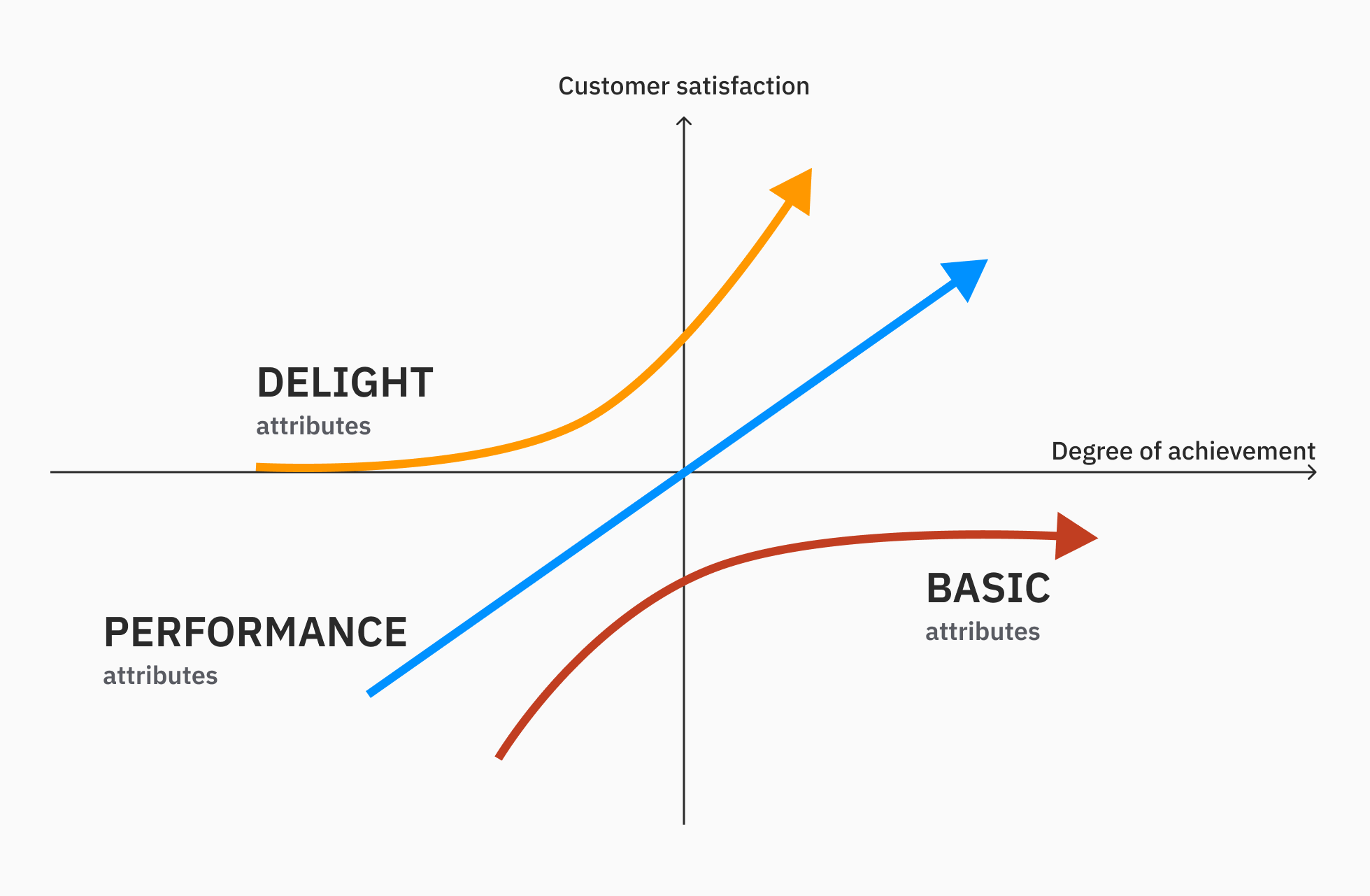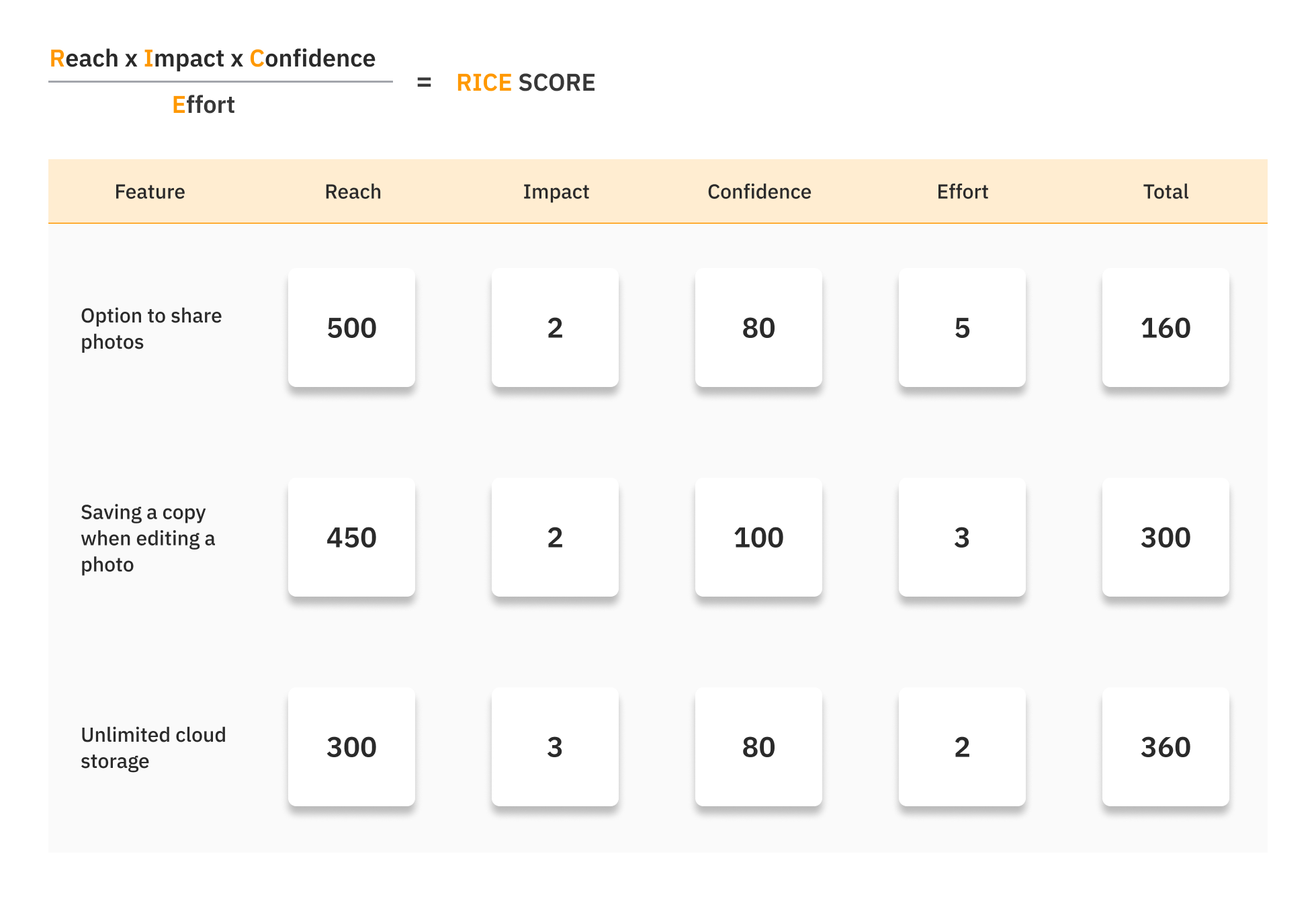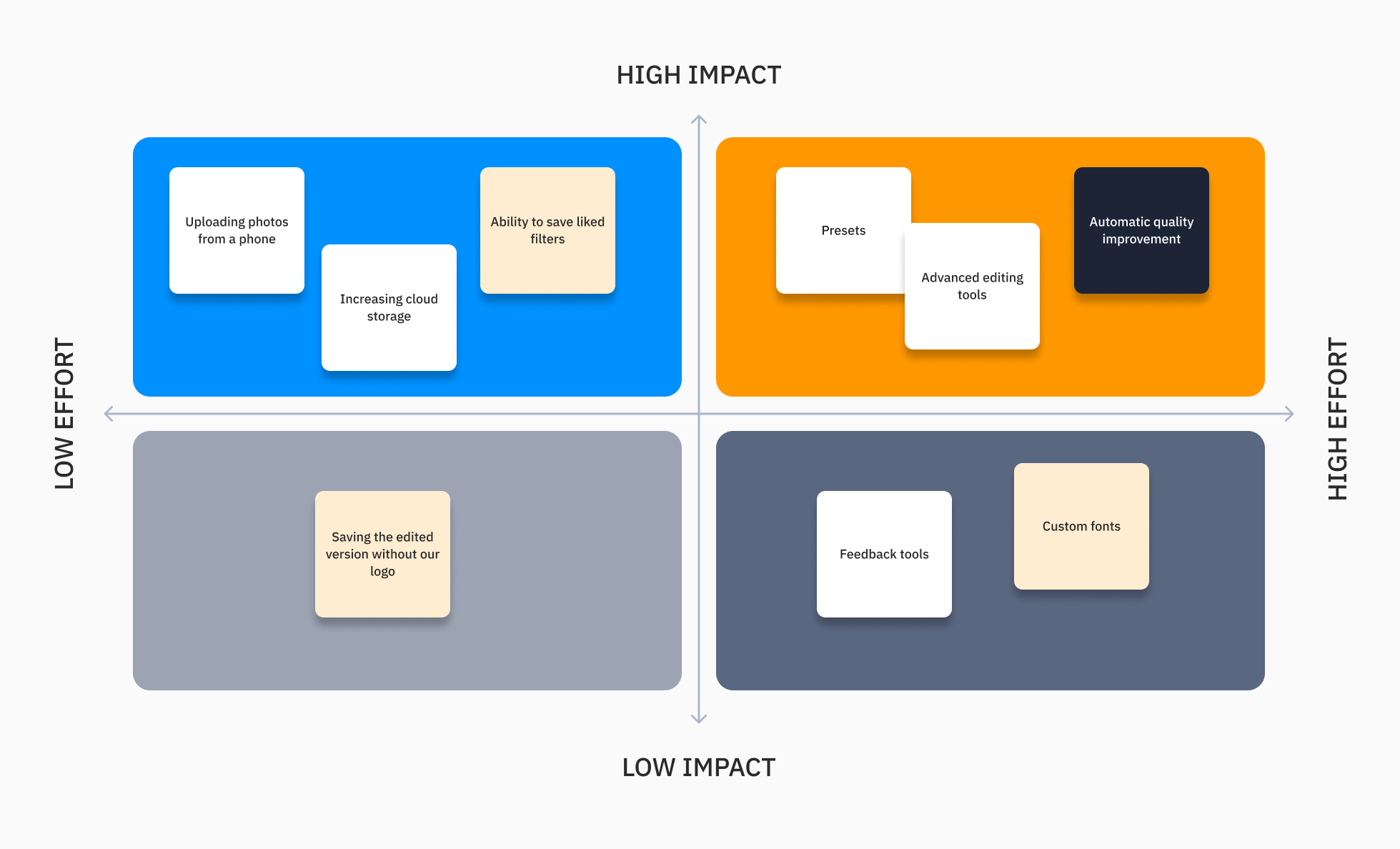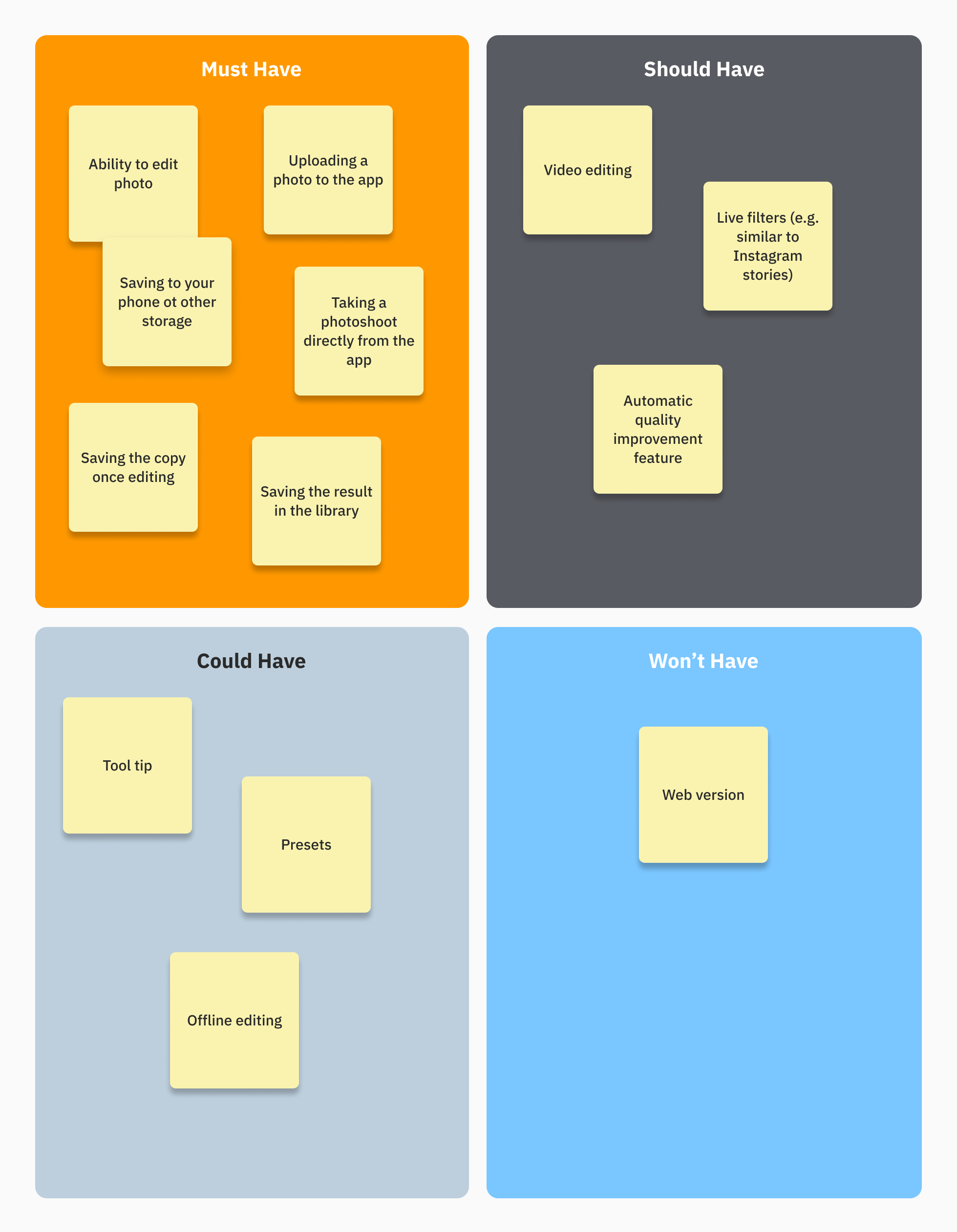In the ever-changing world of product development, where almost 90% of startups face failure, turning an idea into a winning product demands an intelligent approach. It’s a tough reality, and what’s even more challenging is that many of these startups had fantastic ideas. Yet, having a winning idea doesn’t guarantee a smooth ride to success. This is where MVP feature prioritization comes into play – a practical strategy that can add more value than you might realize.
Recognizing the pivotal role that MVPs play in the startup journey, it’s essential to grasp the art of feature prioritization. This isn’t just a checkbox on your to-do list; it’s a skill that demands mastery and experience. Our article serves as your comprehensive guide through this critical process. We’ll navigate the intricacies of MVP feature prioritization, offering insights and actionable steps to empower you in making the right choices for your product’s success.
What is feature prioritization
MVP feature prioritization is the systematic process of evaluating and ranking the importance of various features or components within a product or project. It involves assessing each feature’s potential impact, resource requirements, and alignment with overarching goals to determine their order of implementation or inclusion.
The Significance of Selecting and Prioritizing MVP Features
The significance of selecting and prioritizing MVP features lies at the heart of successful product development. This process serves as a compass, guiding startups and businesses toward building products that resonate with users and fulfill business goals. Feature prioritization offers a structured approach to product development that brings several advantages to the table:
- User-Centric Approach: By evaluating mvp features from the perspective of user needs and preferences, businesses can create products that address pain points directly, enhancing user satisfaction and engagement.
- Resource Optimization: Prioritizing mvp features allows teams to allocate resources effectively. It prevents valuable time and effort from being invested in non-essential elements, ensuring that development efforts are focused on features with the most impact.
- Faster Time-to-Market: By identifying and implementing core features early on, startups can expedite the product’s time-to-market. This agility is vital in today’s competitive landscape.
- Reduced Risk: Feature prioritization minimizes the risk of launching a product laden with unnecessary or underutilized features. This lean approach mitigates the chances of failure and increases the product’s chances of success.
- Iterative Improvement: An MVP developed with carefully prioritized features can serve as a solid foundation for iterative improvements. Startups can build upon a functional core, adding features based on user feedback and evolving market trends.
In essence, feature prioritization empowers startups to make informed decisions that contribute to a product’s relevance, efficiency, and value – factors crucial for standing out in the market and achieving sustained growth.

How to define key features for a successful MVP?
Defining key mvp features for a successful Minimum Viable Product (MVP) is crucial to ensure that you deliver a functional version of your product that addresses core user needs while minimizing development time and resources. Here’s a step-by-step guide to help you define these key features effectively:
- Identify User Needs and Pain Points: Understand your target audience and their problems. Conduct market research, surveys, and interviews to gather insights into what users need and what challenges they face.
- Define Your MVP’s Core Purpose: Clearly outline the primary goal of your MVP. What specific problem will it solve for your users? This goal will serve as the foundation for determining the key features.
- Prioritize Features: Not all features are equally important. Prioritize the features that directly align with your MVP’s core purpose and are essential to its functionality. Consider using techniques like the MoSCoW method (Must have, Should have, Could have, Won’t have) to classify features based on their importance.
- Create User Stories: Break down your prioritized features into user stories. User stories describe the interaction between a user and the product and provide context for the development team. Each story should follow the format: “As a [user], I want to [do something] so that [achieve a goal].”
- Set Clear Scope: Define the boundaries of your MVP. Avoid feature creep by clearly outlining what’s in and out of scope. Stick to the minimum set of features that will allow users to achieve the core purpose.
- Focus on Must-Have Features: Concentrate on the features that are critical for delivering value to users. These are the features that align with your MVP’s primary goal and differentiate it from a mere prototype.
- Build a Prototype: Create a low-fidelity prototype or wireframe to visualize the flow and interaction of the key features. This can help you validate your assumptions before investing in significant development efforts.
- Keep It Simple: Aim for simplicity and elegance in your MVP. Complex features can increase development time and risk. Focus on delivering a solid user experience with essential functionality.
- Iterate and Gather Feedback: Launch your MVP to a small group of users or stakeholders and gather their feedback. This real-world feedback can help you refine and improve your product.
- Measure and Analyze: Define success metrics that align with your MVP’s purpose. Monitor these metrics once your MVP is in use to assess its impact and identify areas for improvement.
- Iterate Again: Use the feedback and data from the initial MVP release to make informed decisions about the next set of features to add. Iterate your product based on user feedback and changing market conditions.
- Avoid Feature Bloat: As you iterate and enhance your product, be mindful of adding too many features that deviate from the core purpose. Continuously assess whether new features align with your product’s overall vision.
Remember, the key to a successful MVP is to strike a balance between delivering value to users and conserving resources. By focusing on the core purpose, prioritizing must-have features, and iterating based on feedback, you can create an MVP that sets a solid foundation for your product’s growth.

How to prioritize features for your MVP
Prioritizing your minimum viable product (MVP) features involves a systematic approach to identify and focus on the most critical functionalities that align with your product’s core purpose. Here’s a step-by-step guide to help you prioritize features effectively:
- Review Your MVP Definition: Make sure you have a clear understanding of your MVP’s primary goal and purpose. This will serve as your anchor when prioritizing features.
- Categorize Features: If you haven’t done so already, categorize the defined features into groups like “Must-Have,” “Should-Have,” “Could-Have,” and “Won’t-Have.” This helps you distinguish between essential and secondary features.
- Align with MVP Goal: Focus on the features that directly align with your MVP’s primary goal. These are the “Must-Have” features that are critical for solving the user’s problem.
- Consider User Impact: Evaluate how each feature impacts the user experience. Prioritize minimum viable product (MVP) features that provide the most value to users and have a substantial impact on addressing their needs.
- Evaluate Technical Feasibility: Assess the technical complexity of implementing each feature. Prioritize features that are achievable within the available development timeframe and resources.
- Analyze Dependencies: Consider any feature dependencies. If a certain feature is a prerequisite for others, it might need to be prioritized higher to enable the development of subsequent features.
- Assess Effort vs. Reward: Rank features based on the effort required to develop them versus the value they bring to users. Prioritize features that offer a significant user benefit relative to the development effort.
- Review Business Goals: Revisit your business goals and objectives. Prioritize features that align with these goals, whether they involve revenue generation, user engagement, or other key performance indicators.
- Address User Pain Points: Identify which features directly address the most pressing pain points of your target users. These features should receive higher priority as they enhance user satisfaction.
- Validate with Stakeholders: Discuss the prioritized features with key stakeholders, including team members, investors, and potential users. Their insights can provide a broader perspective on feature importance.
- Allocate Resources Wisely: Consider your available resources, including time, budget, and team expertise. Prioritize features that can be realistically implemented with your current resources.
- Evaluate Competition: Analyze your competitors’ offerings. Prioritize features that give your MVP a competitive edge or differentiate it in the market.
- Focus on User Onboarding: Prioritize features that contribute to a smooth user onboarding process. Ensuring a positive first impression can lead to higher user retention.
- Create a Roadmap: Based on the prioritization, create a roadmap that outlines the order in which minimum viable product (MVP) features will be developed and released. This roadmap will guide your development process.
- Iterate Based on Feedback: If you’ve already gathered feedback on your defined features, use this input to further refine your priorities. Be open to adjusting the order based on user insights.
Remember, the key is to keep the user’s needs and the MVP’s core purpose at the forefront of your prioritization process. By focusing on the most valuable and essential features, you can create an MVP that effectively addresses user pain points and provides a strong foundation for future growth.
MVP feature prioritization models
When determining the feature priorities for your Minimum Viable Product (MVP), it’s worth noting that there are various prioritization models available. These models offer versatility, catering to different project contexts, and can provide valuable guidance beyond the outlined steps.
Kano Model
The Kano Model categorizes minimum viable product (MVP) features based on how they contribute to user satisfaction. It distinguishes between Basic Needs, Performance Needs, and Delighters.
- Basic Needs: Focus on core functionalities that are expected.
Example: A photo editing app MVP must include core features like capturing photos and recording videos to meet user expectations for a media creation app MVP. - Performance Needs: Enhance user satisfaction by offering features that provide additional value.
Example: Enhance user satisfaction by offering features like real-time filters and basic editing tools, which provide added value and better usability.
Delighters: Surprise users with unexpected features that exceed expectations. Example: Surprise users with unexpected features such as AI-powered background removal for photos and dynamic transitions for videos, exceeding their expectations and enhancing the creative experience.

RICE Scoring Method
The RICE Scoring method quantifies feature prioritization based on Reach, Impact, Confidence, and Effort.
- Reach: Evaluate the potential number of users impacted.
Example: Photo and video editing tools can appeal to a wide user base, including photography enthusiasts, content creators, and social media users. - Impact: Measure the degree of improvement the feature offers.
Example: Photo and video editing capabilities can significantly enhance the quality of user-generated content, leading to more engaging media. - Confidence: Rate the certainty in your impact estimation.
Example: Past feedback and market research can provide high confidence that improved editing tools will positively affect user engagement. - Effort: Assess the resources required to develop the feature.
Example: Developing user-friendly editing features might involve moderate effort due to interface design, algorithm development, and testing.

Effort and Impact Method
The Effort and Impact method is a systematic approach to prioritize MVP features based on two fundamental criteria: the potential Impact a feature offers and the Effort required for its implementation. This method is particularly valuable when resources are constrained, as it allows you to identify features that provide significant value while optimizing resource allocation.
- Prioritization Process: You can assign numerical scores for Impact and Effort to each feature so you can plot them on a matrix where Impact is on one axis and Effort on the other. Features that offer high Impact with relatively lower Effort are prime candidates for prioritization.

MoSCoW Method
The MoSCoW Method categorizes MVP features into Must-Have, Should-Have, Could-Have, and Won’t-Have features. This method, unlike the other ones, allows you to evaluate potential features that might damage your product.
- Must-Have: These are features that are essential to the app’s core functionality.
Example: Capturing photos and recording videos is crucial for fulfilling the app’s purpose. - Should-Have: These features enhance the user experience without being strictly necessary for launch.
Example: Basic photo filters and video trimming tools fall into this category, making the app more user-friendly. - Could-Have: These features provide additional value and can be considered once the core functionality is in place.
Example: More advanced editing tools like color correction and video transitions could enhance the app’s appeal. - Won’t-Have: These are the features intentionally excluded from the MVP to ensure a focused development scope and prevent potential negative impacts on the product.
Example: Certain features, such as complex 3D effects or AI-powered scene recognition, might be intentionally excluded from the MVP to ensure a timely launch and avoid unnecessary complexity.

Using these structured models in harmony can effectively guide the feature prioritization process for the photo and video editing app, aligning user needs and business goals while creating a strong foundation for future growth and development.
CyberCraft's experience in MVP features development
CyberCraft is your trusted partner in MVP feature development, backed by a proven track record. Our portfolio boasts over 150 successful global projects, a testament to our expertise and dedication. Acknowledged as a top-rated development company by Clutch, we consistently deliver quality solutions.
What truly sets CyberCraft apart is our comprehensive approach to development. We’re not just developers; we’re dedicated to shaping digital success stories. From conceptualizing MVPs to launching them in the market, we’re your end-to-end solution provider, ensuring your product resonates with users and achieves your business goals.
Our expertise spans a wide range of domains, thanks to our talented team of professionals who bring a wealth of insights to every project. Whether it’s mobile or web development, design solutions, or beyond, we have the multidisciplinary know-how to make your MVP not just functional, but transformational in your industry. At CyberCraft, we’re not just software experts; we’re your partners in realizing your visions.
Find out more information about our projects here.
Final thoughts
The MVP is a pivotal cornerstone in business development, offering vital insights while mitigating risks. As you can see, prioritizing features can be challenging at times, as it shapes the user experience and determines your market success. With the above methods, it is easier to assess the potential of your product and prioritize it properly.
However, seeking guidance from seasoned professionals will help you reach your goal much faster. At CyberCraft, we bring expertise in software development and strategic decision-making and can help you in MVP feature prioritization as well as in developing your product. Feel free to contact our team for expert consultation.
FAQ
MVP feature prioritization is the process of strategically selecting and ranking features for your Minimum Viable Product (MVP) based on factors like user value, market demand, and resource constraints.
The ideal number of features for an MVP varies, but it's recommended to keep it minimal, focusing on core functionalities that solve a specific problem or deliver value to users.
Yes, you can add more features to your MVP in subsequent iterations. It's a common practice to enhance and expand your product based on user feedback and evolving market needs.
To avoid feature bloat, prioritize features that directly align with your product's main goal. Focus on solving a specific problem for your target audience without including unnecessary functionalities.
Market research provides insights into user preferences, needs, and industry trends. It helps you make informed decisions about which features will have the most impact and appeal to your target audience.
Determine MVP features by considering factors like user needs, value proposition, and the core problem your product solves. Utilize techniques like user stories, feature categorization models, and market research to guide your decision-making process.



